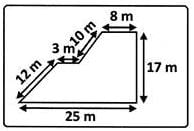Mathematics Practice Test - 5 - Class 5 MCQ
20 Questions MCQ Test - Mathematics Practice Test - 5
A’s salary was increased from Rs. 5000 to Rs. 6000. What was the percentage increase in his salary?
The given figure represents a field. Kalyan jogged 5 rounds and walked 4 rounds along the perimeter of the field.

What was the total distance Kalyan walked and jogged?

By how many times do the place values of the digits increase from right to left in a number?
A box full of buttons has a mass of 2 kg. When it is 1/3 full, its mass is only 800 g. What is the mass of the box?
The salary of a man has increased by 20%. Now if he gets Rs. 3000, what was his salary before the increment?
The salary of a man has increased by 20%. Now if he gets Rs. 3000, what was his salary before the increment?
The figures below are divided into equal parts.

Which two figures are shaded to show equivalent fractions?
What is the difference between the smallest 6-digit odd number and the largest 4-digit even number?
What is the value of 11.047 rounded off to the nearest tenth?
17, 19, p, 29, 31, q, 41 is a list of prime numbers in ascending order. What is the value of q - p?
If Rs. 60 is divided into two parts in the ratio of 2 : 3, find the difference between the two parts.
A cube of edge 9 cm was filled with 405 cm3 of water. Find the height of water in the cube?
Sunitha is 65 years old and her son is 36 years old. How many years ago was sunitha's age twice the age of her son?
A bat is sold for Rs. 1728 by making a profit of Rs. 198. What is the cost price of the bat?
If the length and breadth of a rectangle are doubled how does its perimeter change?
A number has 1 decimal place. It is 49 when rounded off to the nearest whole number. What could the greatest possible value of the number be?
















